-
Paper Information
- Paper Submission
-
Journal Information
- About This Journal
- Editorial Board
- Current Issue
- Archive
- Author Guidelines
- Contact Us
Computer Science and Engineering
p-ISSN: 2163-1484 e-ISSN: 2163-1492
2025; 15(2): 51-57
doi:10.5923/j.computer.20251502.02
Received: May 3, 2024; Accepted: Jun. 5, 2024; Published: Apr. 16, 2025

A Study on Digitisation of Zambian Intercity Bus Based Public Transport Support Services
Biggie Muntanga, Simon Tembo
Department of Electrical and Electronic Engineering, School of Engineering, University of Zambia, Zambia
Correspondence to: Biggie Muntanga, Department of Electrical and Electronic Engineering, School of Engineering, University of Zambia, Zambia.
| Email: |  |
Copyright © 2025 The Author(s). Published by Scientific & Academic Publishing.
This work is licensed under the Creative Commons Attribution International License (CC BY).
http://creativecommons.org/licenses/by/4.0/

This research study investigates the digitisation of booking and payment services of Zambian of Intercity Bus Transportation Sector to address the inconvenience faced by passengers due to manual ticketing processes. It aims to understand the details for deprived service and how digitisation can enhance customer experience. The study involves stakeholders like bus operators, customers, and local authorities, with data collected through interviews and online questionnaires. It walks through the solution and deduces the sample size based off a few variants to gain 95% confidence in the proposed solution. The proposed digitisation includes developing an integrated online system accessible via web and mobile applications. Overall, the study seeks to improve efficiency, convenience, and satisfaction in intercity bus travel in Zambia through digitisation.
Keywords: Zambia, Digitisation, Booking, Reservation, Payment, Public Transport, Integrated Online System, Services
Cite this paper: Biggie Muntanga, Simon Tembo, A Study on Digitisation of Zambian Intercity Bus Based Public Transport Support Services, Computer Science and Engineering, Vol. 15 No. 2, 2025, pp. 51-57. doi: 10.5923/j.computer.20251502.02.
Article Outline
1. Introduction
- Transportation is essential for providing mobility to the people, and for movement of goods. Transportation facilitates a broad spectrum of opportunities for an individual for desired activities. Though transport is not an end in itself, it is the means to many ends. Efficient transportation results in economic, social and political advantages [1]. Public Transport transportation is a system for taking people from one place to another, for example, using buses or trains [2]. Buses are the widely used mode of transport by the public to move from one town to another town. Big buses depart Lusaka from Intercity Bus station to towns such as Kapiri-Mposhi, Livingstone, Ndola and to neighbouring countries like Zimbabwe, Botswana, Malawi, Tanzania and more. Schedules can be obtained and bus tickets by going to Intercity bus stop in advance. Tickets are also purchased on the day of travel [3]. Public transportation has become an important part of urban life in many African countries and especially for fast growing cities. As cities expand rapidly, concerns about the effectiveness of within and outside city movements of people are becoming a source of worry and an important policy issue for many governments on the continent. This is because urban public transportation has important linkages with economic growth, productivity, social change and general well-being of the urban population. For many African countries public transport experienced a transformation especially following liberalisation of most economies in the 1990s, moving from public run systems to include private sector participation. This transformation did not leave out Zambia. The period after 1991 was characterised by an influx of private passenger vehicles into the country leading to an exponential growth in the number of public transport operators. In general, this improved the availability of public transport within and across cities making it relatively easier for people to connect between places compared to before [4].
2. Literature Review
- In the contemporary era, the demand for convenient and budget-friendly intercity travel solutions has surged. Traditionally, purchasing bus tickets involved enduring long queues at bus terminals or navigating through multiple carrier websites and apps, causing confusion and consuming time [5]. However, the advent of e-ticketing systems has revolutionized ticket purchasing by offering round-the-clock accessibility and eliminating geographical constraints, thereby enhancing traveller convenience and enabling service providers to monitor traveller behaviour effectively [6]. Zambia's mobile connectivity landscape reflects a significant opportunity for the development of online systems accessible to a large user base across the country [7]. While industries like hospitality and air travel have successfully integrated online booking systems, the intercity bus sector remains predominantly offline [8]. The integration of information and communication technology (ICT) in transportation holds immense potential to enhance mobility, safety, and efficiency. Technological advancements such as travel information systems and online booking platforms cater to evolving consumer preferences for comfort, safety, and speed [9]. Previous studies indicate that various companies and transport agencies, including DotCom Zambia and Mazhandu Family Bus Services, have embraced e-ticketing and reservation systems to streamline operations and enhance customer satisfaction [10]. However, challenges such as low internet penetration and system maintenance issues have hindered widespread adoption. The emergence of smartphone applications has further transformed consumer behaviour, facilitated seamless online transactions and fostered closer company-customer relationships [11]. E-ticketing systems in public transport not only serve as payment methods but also process vast amounts of data, offering opportunities for improved management and integration of pricing structures [12].The suitable flow of the system will be construed after the conducting the research on digitisation of public transport on the case study of intercity bus booking and reservation services. Bus Reservations Systems allocate available seats by employing the algorithm or formular below:Availability = Capacity – Current Occupancy – Requested Guest• Capacity is the maximum number of guests the reservation system can accommodate.• Current Occupancy is the current number of guests already booked for the requested date and time.• Requested Guests be the number of guests for the new reservation.If Availability ≥0, it means there are enough slots available to accommodate the new reservation. Otherwise, there is not enough capacity, and the reservation cannot be accommodated. This formula provides a simple way to check whether a reservation slot is available within the capacity limit of the system.The system should allow users to check seat availability, book seats, cancel bookings, and view current reservations. Below is a basic flow chart for implementation of such a system:
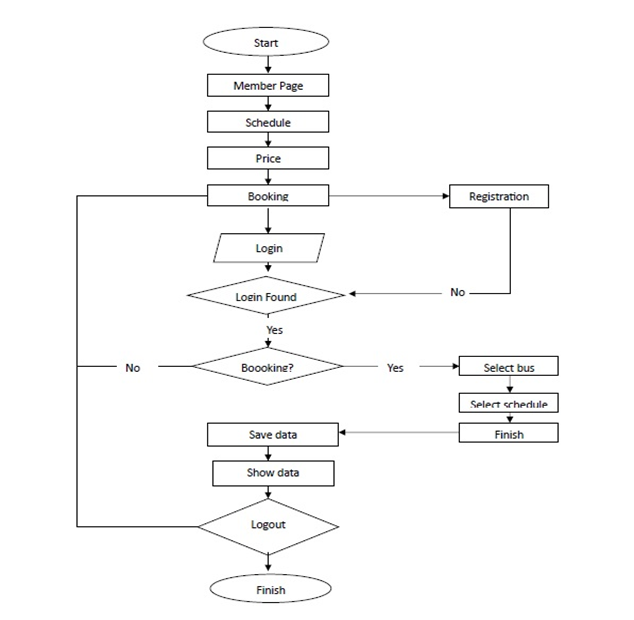 | Figure 1. Flow chart diagram of online booking system |
3. Methodology
- The research focuses on developing an Online Bus Reservation and Booking System, specifically targeting the engineering domain. It employs a qualitative research design, emphasizing interview-based and observational study approaches. This method is chosen due to its suitability for exploring the predominantly manual, paper-based systems currently in use for intercity bus operations. The qualitative approach is ideal for gaining deep insights into user experiences, preferences, behaviours, and the factors influencing the adoption of online reservation systems. The study targets the public using intercity buses in Lusaka city, including stakeholders like bus operators, conductors, the council, and bus owners. Lusaka, being a central hub for intercity and international bus services within the Southern Africa Development Community (SADC) and Common Market for Eastern and Southern Africa (COMESA) regions, presents an ideal setting for this research.The Sampling technique suitable for this research study is Simple Random Sampling. Simple random sampling is a statistical method in which everyone in a population has an equal chance of being selected into a sample. The sample represents a smaller and more manageable portion of the people that can be studied and analysed. It’s a fundamental technique to gather data and make inferences for a finite population. Sample Size for this research study was deduced from the target Population Size of 15,000 participant, Confidence Level of 95% and Margin of Error of 5%. Sample size is the number of observations in a sample. It is commonly denoted n or N. Confidence/risk level is the degree to which an assumption or number is likely to be true. That is the probability that a random variable lies within the confidence interval of an estimate. The margin of error represents the range within which the true population parameter is estimated to lie, with a given level of confidence, based on a sample from that population [13]. The Sample Size for this study has been calculated using mathematical and python programming language in code shown below.(i) Mathematical Sample Calculation
 Where:n = sample size.N = population size.Z = Z-score (the number of standard deviations from the mean).p = estimated proportion of the population (typically 0.5 if unknown).E = margin of error.Given the parameters:𝑁 = 15000Confidence level = 95%, so 𝑍 = 1.96Margin of error 𝐸 = 0.05 𝑝 = 0.5 (as a conservative estimate)We shall now proceed to input the provided values into the given formula.
Where:n = sample size.N = population size.Z = Z-score (the number of standard deviations from the mean).p = estimated proportion of the population (typically 0.5 if unknown).E = margin of error.Given the parameters:𝑁 = 15000Confidence level = 95%, so 𝑍 = 1.96Margin of error 𝐸 = 0.05 𝑝 = 0.5 (as a conservative estimate)We shall now proceed to input the provided values into the given formula. (ii) Python Programming Calculation
(ii) Python Programming Calculation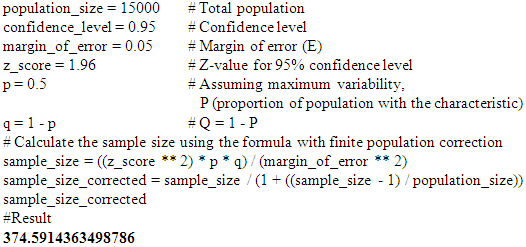 This Sample Size is 375. To achieve a confidence level of 95% with a margin of error of 5% for a population size of 15,000 the calculated sample size, after applying the finite population correction, is approximately 375 individuals. This means you would need to include 375 participants in your study to ensure that your survey results are representative of the larger population with the specified confidence level and margin of error. The dataset reviews responses from a survey regarding intercity bus usage in Zambia, focusing on variables like gender, age, occupation, bus usage frequency, favourite operators, and reservation practices. It also examines user satisfaction with the current reservation process, the challenges faced, and the time in advance that tickets are booked. Moreover, it explores payment methods, user satisfaction with these methods, and the factors influencing service choice. The dataset also gauges the overall convenience of the bus reservation system, awareness of online systems, the probability of recommending such systems, and the desired features in an online reservation system. This comprehensive dataset is essential for understanding current trends and identifying areas for improvement in the intercity bus service domain. Here below are the results from the collected data.
This Sample Size is 375. To achieve a confidence level of 95% with a margin of error of 5% for a population size of 15,000 the calculated sample size, after applying the finite population correction, is approximately 375 individuals. This means you would need to include 375 participants in your study to ensure that your survey results are representative of the larger population with the specified confidence level and margin of error. The dataset reviews responses from a survey regarding intercity bus usage in Zambia, focusing on variables like gender, age, occupation, bus usage frequency, favourite operators, and reservation practices. It also examines user satisfaction with the current reservation process, the challenges faced, and the time in advance that tickets are booked. Moreover, it explores payment methods, user satisfaction with these methods, and the factors influencing service choice. The dataset also gauges the overall convenience of the bus reservation system, awareness of online systems, the probability of recommending such systems, and the desired features in an online reservation system. This comprehensive dataset is essential for understanding current trends and identifying areas for improvement in the intercity bus service domain. Here below are the results from the collected data.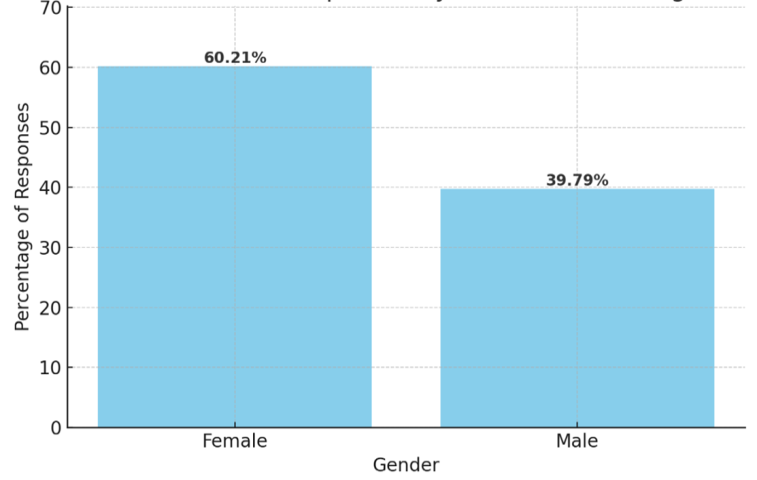 | Figure 2. Gender distribution of intercity bus customers |
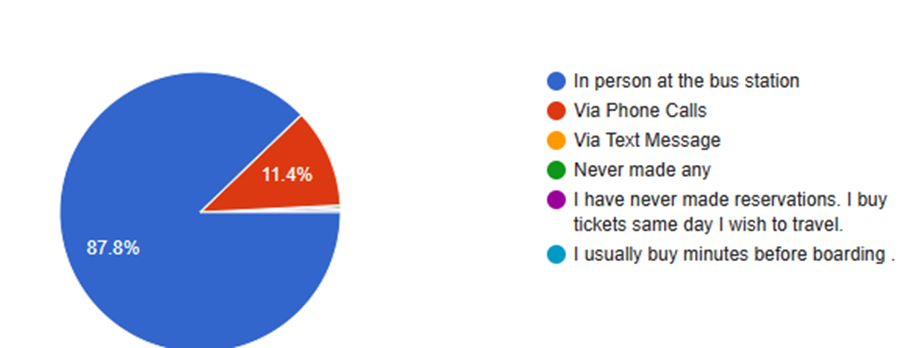 | Figure 3. Methods used for making reservations of bus tickets. |
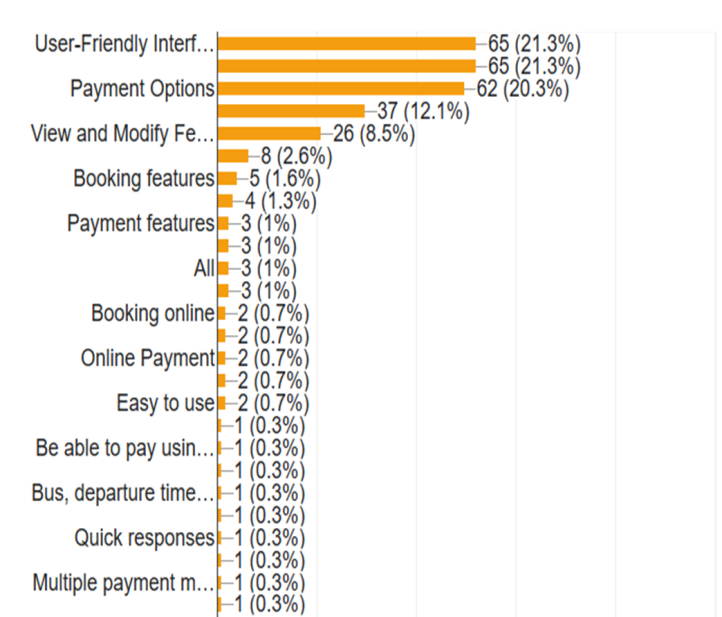 | Figure 4. Desired features for the online bus ticket reservation and payment system |
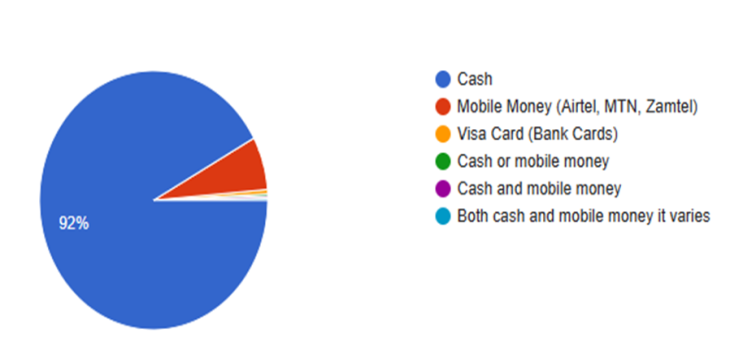 | Figure 5. Payment methods used for buying intercity bus tickets |
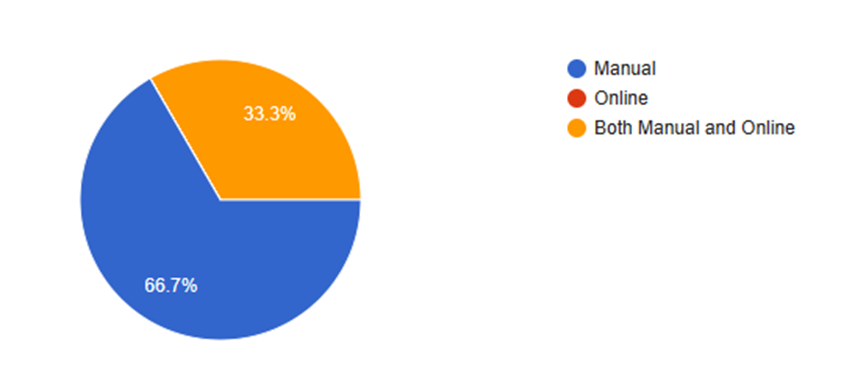 | Figure 6. Current booking system at Intercity Bus Station |
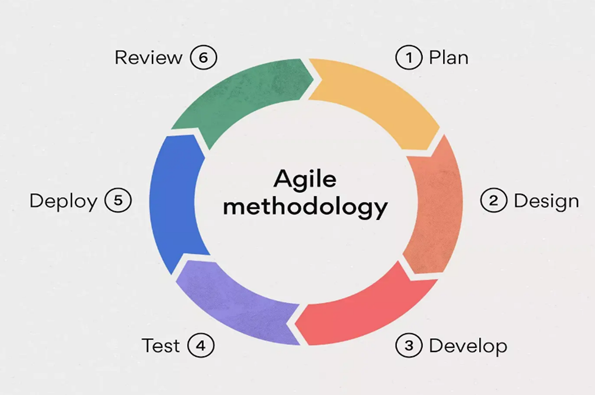 | Figure 7. Agile methodology diagram |
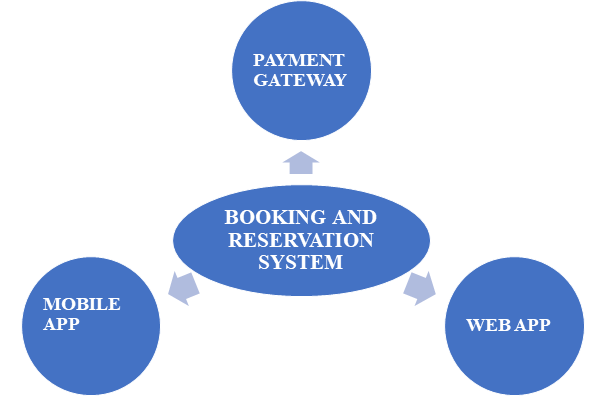 | Figure 8. Reservation System Overview |
4. Findings and Discussion
- Findings indicate that there is a significant engagement with intercity bus services customer, operator among various stakeholders. Intercity bus customers, frequently use these services, predominantly booking their tickets through traditional, in-person methods at bus stations. Notably, approximately 59% of these customers are aware of online reservation systems, and there is a high level of receptiveness towards adopting digital solutions. The potential benefits of an online bus reservation system as identified by customers include increased convenience, time savings, and enhanced transparency in scheduling and fare pricing. The demand for user-friendly interfaces and flexible payment options highlights the importance of customer-centric designs in the development of new technologies. Operators recognise that online booking systems can lead to improved operational efficiency, better record-keeping, and enhanced customer service. However, they also express concerns regarding the costs of implementation and the adaptability of their current workforce and customer base to new technologies. Government perspectives underscore a strategic commitment to enhancing public transportation through digitalization. The support from government initiatives is seen as crucial for overcoming the significant infrastructural and financial challenges associated with such transitions.The integration of digital solutions in the Zambian intercity bus reservation system presents a significant opportunity to enhance service delivery and operational efficiency. However, this transition requires careful consideration of the following factors:1. Market Readiness: There is clear evidence of market readiness for digital solutions, as stakeholders across the board express interest and willingness to adopt new technologies. The development of these systems must align with user needs and local market conditions to ensure high adoption and sustained use.2. Government Involvement: Active government participation is essential not only in terms of funding and policy support but also in facilitating the necessary regulatory frameworks that encourage innovation while ensuring consumer protection and fair competition.3. Customer Experience: Digitisation offers a pathway to significantly improve customer experiences, but this requires the deployment of systems that are accessible, reliable, and easy to use. Addressing the digital divide and ensuring inclusivity in access to new technologies will be crucial.4. Operational Challenges: Implementing digital systems involves addressing several challenges, including the initial financial outlay, the integration with existing infrastructure, and the training of both staff and customers. These issues require strategic planning and phased implementation strategies.
5. Conclusions
- In conclusion, the Online Bus Reservation and Payment System marks a significant step forward in modernising public transportation, offering benefits to both customers and operators. By leveraging technology, the system addresses many of the challenges traditionally associated with bus travel, paving the way for a more efficient, accessible, and user-friendly public transportation ecosystem. As adoption grows and technology advances, the system has the potential to transform public transportation into a more attractive, convenient, and sustainable option for travellers.
Future Recommendations
- To improve the digitisation of Zambia’s Intercity Bus Booking System. Implementation of a confirmation step and grace period to address wrong bookings and checks to detect and warn users of duplicate bookings is ideal. Development real-time seat inventory management to prevent overbooking and add safeguards to resolve duplicate payments promptly. Enhance the refund management system for efficiency and transparency. Continuously refining the user interface and developing of web and mobile application will improve accessibility. Integrating customer support within the platform will provide prompt assistance. Strengthening data security measures and implementing analytics and reporting tools will monitor performance and user behaviour. These steps aim to enhance user satisfaction, operational efficiency, and system reliability.
ACKNOWLEDGEMENTS
- I extend my sincere gratitude to my Supervisor, Dr. Simon Tembo, for his invaluable guidance, encouragement, and expert advice throughout the duration of this research. His profound knowledge and insightful feedback have been instrumental in shaping both the direction and the outcome of this study. I also wish to express my appreciation to my employer, the Insurers Association of Zambia, for their understanding and support. Their flexibility and encouragement provided me with the opportunity to pursue this research while fulfilling my professional obligations. Their contribution has been a vital component of my ability to undertake and complete this research. The assistance and resources provided by these parties have greatly contributed to the success of this research. Their support has not only facilitated my academic journey but also contributed to my professional growth and development. I am deeply thankful for their unwavering support.
 Abstract
Abstract Reference
Reference Full-Text PDF
Full-Text PDF Full-text HTML
Full-text HTML